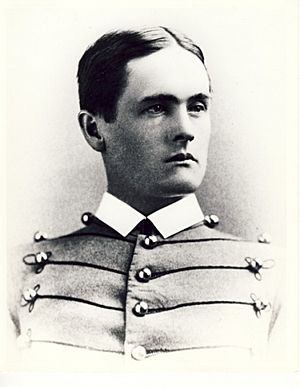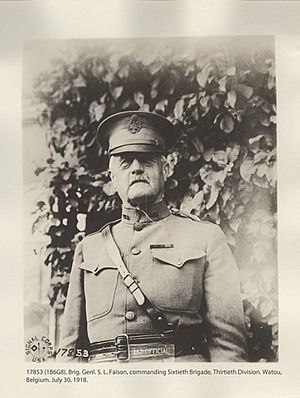Samson L. Faison facts for kids
Samson Lane Faison (born November 29, 1860 – died October 17, 1940) was an important United States Army general. He led the 30th Infantry Division at different times during World War I. He earned the Distinguished Service Medal for his big part in breaking through the German Hindenburg Line.
Quick facts for kids
Samson Lane Faison
|
|
|---|---|
 |
|
| Born | November 29, 1860 Faison, North Carolina |
| Died | October 17, 1940 (aged 79) Baltimore, Maryland |
| Allegiance | |
| Service/ |
|
| Years of service | 1883-1922 |
| Rank | |
| Commands held | 30th Infantry Division |
| Battles/wars | Apache Wars Philippine–American War World War I |
| Awards | Distinguished Service Medal |
| Relations | LCDR S. Lane Faison (son) |
Contents
Early Life and Family
Samson L. Faison was born in Faison, North Carolina. His parents were Elias James Faison and Elizabeth Maria Lane. He grew up with four brothers and two sisters. Today, a special historical marker stands in his hometown. It tells people about his birthplace and his achievements.
In 1906, Faison married Eleanor Sowers. They had two children, a son named S. Lane Faison Jr. and a daughter named Eleanor. His son, Lane, became a famous art historian. He also worked to find stolen art during World War II.
Military Career Highlights
Serving in the Apache Wars
Samson Faison finished his studies at West Point in 1883. He then served in Arizona from 1883 to 1886. This was during the last years of the Apache Wars. In 1885, General George Crook chose Lieutenant Faison for a special mission. He was to lead Apache Scout Companies into Mexico. Their goal was to track down the Apache leader, Geronimo.
Faison spent 11 months in the field during this time. He was one of the few officers present when General Crook met with Geronimo in March 1886. A famous photographer, C. S. Fly, took pictures of this important meeting. General Crook later praised Faison and other officers. He said they bravely handled "incredible fatigues and privations" while leading their missions. Years later, in 2012, Faison's own story about the Geronimo Campaign was published.
Teaching and Fighting in the Philippines
From 1896 to 1899, Lieutenant Faison was a senior teacher at the United States Military Academy. He taught soldiers how to fight. In 1899, Captain Faison left West Point. He went to fight in the Philippine–American War. There, he took part in many battles against the Philippine uprising.
He also served in other important roles in the Philippines until 1902. He was an adjutant general and a judge. After that, he returned to the U.S. and took command of Fort Mason in San Francisco.
Learning at Army War College
Major Faison attended the United States Army War College from 1910 to 1911. This college helps train top military leaders. After he graduated, he worked there for a short time as a teacher and an administrator.
Leading in World War I
When the United States joined World War I, Colonel Faison was promoted. In August 1917, he became a brigadier general. He then took command of the 60th Brigade of the 30th Infantry Division. General Faison led this division many times. He commanded them during their training in South Carolina and later in France.
During a big battle in September–October 1918, Faison's brigade made history. Some say they were the first Americans to break through the German Hindenburg Line. This happened at Bellicourt, France. Because of his bravery and leadership, Faison received the Distinguished Service Medal. His award stated:
General Faison led the 60th Infantry Brigade with great skill. He helped break the enemy's Hindenburg line in France. He also helped capture important areas. This showed he was a very strong and determined military leader.
Later Years and Retirement
After World War I ended, Faison returned to his rank of colonel. However, he was officially promoted to brigadier general in 1922. He retired from the army later that same year. He retired because of health problems.
Samson Faison passed away in Baltimore, Maryland, on October 17, 1940. He was 79 years old. He is buried at Arlington National Cemetery.
Awards and Honors
Here are the awards Brigadier General Faison received:
| 1st Row | Army Distinguished Service Medal | Indian Campaign Medal | Philippine Campaign Medal | |||||||||
|---|---|---|---|---|---|---|---|---|---|---|---|---|
| 2nd Row | World War I Victory Medal with three battle Clasps | Officer of the Legion of Honour (France) | Croix de guerre 1914–1918 with Palm (France) | |||||||||
Images for kids
-
British King George V reviewing the troops of the 114th Machine Gun Battalion of the 30th Division in France, August 6, 1918. King George is in the foreground to the left, Major General Edward M. Lewis, commanding the 30th Division, is in the foreground to the right. Over the right shoulder of the King and behind him is Brigadier General Samson L. Faison, commanding the 30th Division's 60th Brigade.




